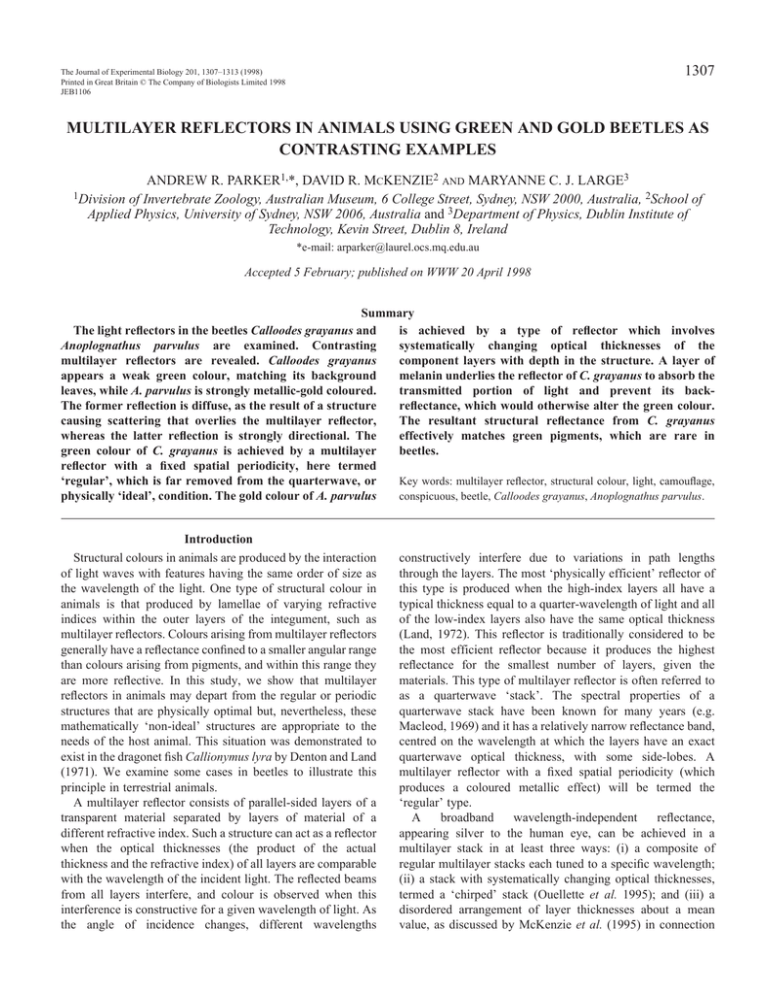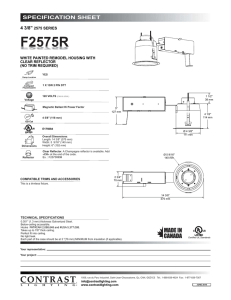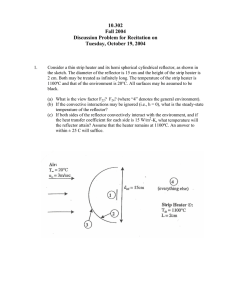multilayer reflectors in animals using green and gold beetles as
advertisement

1307 The Journal of Experimental Biology 201, 1307–1313 (1998) Printed in Great Britain © The Company of Biologists Limited 1998 JEB1106 MULTILAYER REFLECTORS IN ANIMALS USING GREEN AND GOLD BEETLES AS CONTRASTING EXAMPLES ANDREW R. PARKER1,*, DAVID R. MCKENZIE2 AND MARYANNE C. J. LARGE3 of Invertebrate Zoology, Australian Museum, 6 College Street, Sydney, NSW 2000, Australia, 2School of Applied Physics, University of Sydney, NSW 2006, Australia and 3Department of Physics, Dublin Institute of Technology, Kevin Street, Dublin 8, Ireland 1Division *e-mail: arparker@laurel.ocs.mq.edu.au Accepted 5 February; published on WWW 20 April 1998 Summary The light reflectors in the beetles Calloodes grayanus and is achieved by a type of reflector which involves Anoplognathus parvulus are examined. Contrasting systematically changing optical thicknesses of the multilayer reflectors are revealed. Calloodes grayanus component layers with depth in the structure. A layer of appears a weak green colour, matching its background melanin underlies the reflector of C. grayanus to absorb the leaves, while A. parvulus is strongly metallic-gold coloured. transmitted portion of light and prevent its backThe former reflection is diffuse, as the result of a structure reflectance, which would otherwise alter the green colour. causing scattering that overlies the multilayer reflector, The resultant structural reflectance from C. grayanus whereas the latter reflection is strongly directional. The effectively matches green pigments, which are rare in green colour of C. grayanus is achieved by a multilayer beetles. reflector with a fixed spatial periodicity, here termed Key words: multilayer reflector, structural colour, light, camouflage, ‘regular’, which is far removed from the quarterwave, or conspicuous, beetle, Calloodes grayanus, Anoplognathus parvulus. physically ‘ideal’, condition. The gold colour of A. parvulus Introduction Structural colours in animals are produced by the interaction of light waves with features having the same order of size as the wavelength of the light. One type of structural colour in animals is that produced by lamellae of varying refractive indices within the outer layers of the integument, such as multilayer reflectors. Colours arising from multilayer reflectors generally have a reflectance confined to a smaller angular range than colours arising from pigments, and within this range they are more reflective. In this study, we show that multilayer reflectors in animals may depart from the regular or periodic structures that are physically optimal but, nevertheless, these mathematically ‘non-ideal’ structures are appropriate to the needs of the host animal. This situation was demonstrated to exist in the dragonet fish Callionymus lyra by Denton and Land (1971). We examine some cases in beetles to illustrate this principle in terrestrial animals. A multilayer reflector consists of parallel-sided layers of a transparent material separated by layers of material of a different refractive index. Such a structure can act as a reflector when the optical thicknesses (the product of the actual thickness and the refractive index) of all layers are comparable with the wavelength of the incident light. The reflected beams from all layers interfere, and colour is observed when this interference is constructive for a given wavelength of light. As the angle of incidence changes, different wavelengths constructively interfere due to variations in path lengths through the layers. The most ‘physically efficient’ reflector of this type is produced when the high-index layers all have a typical thickness equal to a quarter-wavelength of light and all of the low-index layers also have the same optical thickness (Land, 1972). This reflector is traditionally considered to be the most efficient reflector because it produces the highest reflectance for the smallest number of layers, given the materials. This type of multilayer reflector is often referred to as a quarterwave ‘stack’. The spectral properties of a quarterwave stack have been known for many years (e.g. Macleod, 1969) and it has a relatively narrow reflectance band, centred on the wavelength at which the layers have an exact quarterwave optical thickness, with some side-lobes. A multilayer reflector with a fixed spatial periodicity (which produces a coloured metallic effect) will be termed the ‘regular’ type. A broadband wavelength-independent reflectance, appearing silver to the human eye, can be achieved in a multilayer stack in at least three ways: (i) a composite of regular multilayer stacks each tuned to a specific wavelength; (ii) a stack with systematically changing optical thicknesses, termed a ‘chirped’ stack (Ouellette et al. 1995); and (iii) a disordered arrangement of layer thicknesses about a mean value, as discussed by McKenzie et al. (1995) in connection 1308 A. R. PARKER, D. R. MCKENZIE AND M. C. J. LARGE with reflectance in fish skin. These possibilities are illustrated in Fig. 1. The first two of these have been discussed by Denton and Land (1971); the first type can be found in the herring Clupea harengus (Denton and Nicol, 1965). The disordered reflector, termed ‘chaotic’, does not have any variation with depth in the structure, on average. Broadband reflectance is achieved covering the human visible light range and some of the infrared (McKenzie et al. 1995). The ‘chirped’ multilayer reflector can be found in beetles (see Neville, 1977). Although previously illustrated in beetles using transmission electron micrographs (Neville, 1977), a complete interpretation of a ‘chirped’ reflector has not been given in the biological literature and will therefore be explained herein. In the present study, the reflective structures in Anoplognathus parvulus and Calloodes grayanus (Coleoptera) will be examined regarding their physical properties, reflection characteristics and biological functions. A preliminary examination of beetles revealed that these two species, both collected from a variety of leaves, produce obviously different optical effects. Materials and methods The basic colours of Anoplognathus parvulus Waterhouse and Calloodes grayanus (White), as they appear to the human eye, were noted from all angles. Reflected-light micrographs were taken to provide permanent records. Because human vision is different from that of other animals (e.g. Pope and Hinton, 1977), objective reflectances of the dorsal surfaces (head, thorax and abdomen) of A. parvulus and C. grayanus were obtained using an integrating sphere attached to a Beckman DK2A spectrophotometer. Here, the percentage reflectance was measured for light of wavelengths from 0.36 µm (ultraviolet) to 2.5 µm (infrared). Similar integratingsphere measurements were taken from a leaf of Ficus A Fig. 1. Three ways of achieving a broadband, wavelength-independent reflectance in a multilayer stack. High refractive index material is shown shaded. (A) Three regular multilayer stacks, each tuned to a different wavelength. (B) A ‘chirped’ stack. (C) A ‘chaotic’ stack. See text for explanations of each reflector. macrophylla macrophylla (Moreton Bay fig), a plant that occurs commonly in the same region of Australia as A. parvulus and C. grayanus, selected because it possesses rigid leaves which facilitate analysis in an integrating sphere. The colour of the elytra of A. parvulus and C. grayanus was also examined under transmitted light using a white, fibre-optic light source from behind the elytra only. Sections of the elytra from specimens of A. parvulus and C. grayanus were critical-point-dried and fractured using a razor blade, then gold-coated. The edges of the fractured specimens (i.e. vertical sections through the cuticles) were examined using a scanning electron microscope (SEM). Further sections of the above elytra were examined using a transmission electron microscope (TEM). For TEM analysis, the specimens were (i) treated with 2.5 % glutaraldehyde in 0.1 mol l−1 phosphate buffer for 1 h at room temperature (23 °C), (ii) rinsed with 0.1 mol l−1 buffer, (iii) treated with 1 % osmium tetroxide in 0.1 mol l−1 buffer for 1 h at room temperature, (iv) dehydrated through an ethanol series, and (v) infiltrated with Epon resin through a resin–ethanol series (each dilution treatment took place overnight on a rotator). Following the electron microscope analyses, we mathematically modelled structures identified in the cuticle of A. parvulus and C. grayanus to determine their light-reflecting properties. Consequently, the structures responsible for the resulting optical effects could be identified. For these calculations, a program was used to calculate the reflectance and transmittance of a multilayer stack using the matrix method (Macleod, 1969). We used the refractive indices of more- and less-dense chitinous material, known to comprise multilayer reflectors within insect cuticle, given by Bernard and Miller (1968), i.e. 1.73 for the high-index layer and 1.40 for the low-index layer. There is a general lack of information on refractive indices of materials involved in beetle reflectors B C Beetle multilayer reflectors 1309 (Neville, 1977), and such values are difficult to determine experimentally. Another value for the high-index layers in beetles is 1.684; this value is high because the chitin incorporates uric acid (Caveney, 1971; Neville, 1977). We therefore repeated the calculation substituting 1.56 for the high-index layer (a value for chitin given in Land, 1972). Results We found Anoplognathus parvulus to display a bright metallic gold colour from specific parts of its dorsal surface, a type of reflectance termed ‘specular’. The part which appears coloured A is dependent on the angles of viewing and of incident light. From any direction, part of the beetle appears gold (with a green tinge), while the rest of the beetle is a pale, transparent brown (no structural colour observed) (Fig. 2A). The integrating-sphere analysis showed that A. parvulus reflects strongly (over 90 % reflectance) in the green-yellow-orange region of the human visible spectrum, and also in the infrared (Fig. 3). We perceive Calloodes grayanus as a dull green colour from most of its dorsal surface, equally from all directions (Fig. 2B). At normal incidence only, C. grayanus appears yellow in the small, slightly flattened central section of the combined elytra, and at oblique angles only it appears blue in regions of high curvature (except for very limited areas with very high curvatures with respect to the angle of viewing, which appear black). However, this yellow and blue coloration is slight and not noteworthy when the whole animal is viewed. The integrating-sphere analysis showed that C. grayanus reflects strongest in the green region of the human visible spectrum, over a very narrow range of wavelengths, and also in the infrared (Fig. 3). The reflectance in the human visible range, however, was proportionally much lower (approximately 18 % for green) than in A. parvulus. In transmitted light, the elytra of A. parvulus appeared a transparent purple/brown colour, while the elytra of C. grayanus was black and opaque. From Infrared ‘Visible’ 100 Green Anoplognathus parvulus 80 Reflectance (%) B 60 Calloodes grayanus 40 Leaf 20 0 500 1000 1500 2000 2500 Wavelength (nm) Fig. 2. Reflected light micrographs using the same intensity of unidirectional, white light at 8× magnification. (A) Anoplognathus parvulus, head and thorax; note that areas without reflection appear pale brown. (B) Calloodes grayanus, head and part of the thorax; note that areas without reflection appear black. Note also that the reflectance in A is brighter but more specular than in B, and the structural reflectance is brighter than the pigment reflectance (brown) in A and of approximately the same intensity in B. Scale bars, 2 mm. Fig. 3. Integrating-sphere measurements of proportional reflectances (over a complete hemisphere) from the dorsal surfaces of the beetles Anoplognathus parvulus and Calloodes grayanus and from a leaf of Ficus macrophylla macrophylla. Note that this leaf is dull compared with other leaves in the region of Australia that C. grayanus inhabits. The detector was changed from a photomultiplier to a solid-state (lead sulphide) detector at a wavelength of 800 nm. The region of the electromagnetic spectrum as perceived by humans is indicated above. 1310 A. R. PARKER, D. R. MCKENZIE AND M. C. J. LARGE 100 Reflectance (%) 80 60 40 20 0 300 400 500 600 700 800 900 1000 1100 Wavelength (nm) Fig. 5. Graph showing the calculated reflectance from the ‘chirped’ reflector of the gold beetle Aspidomorpha tecta shown in Fig. 4. Fig. 4. Transmission electron micrograph of a section cut vertically through the cuticle of the gold beetle Aspidomorpha tecta. The external surface is uppermost. A ‘chirped’ reflector is evident in the endocuticle. See Fig. 5 for reflectance graph. Photograph by H. E. Hinton, taken from Neville (1977). Scale bar, 1 µm. the integrating-sphere analysis, the leaf of Ficus macrophylla macrophylla showed a similar reflectance pattern to that of C. grayanus in terms of wavelength and reflectivity (Fig. 3). A. parvulus and C. grayanus are structurally coloured as a result of multilayer reflectors in their cuticle, as determined from SEM and TEM analyses. C. grayanus possesses a regular ‘non-ideal’ reflector, in the sense that the optical thicknesses of all layers are not equal. Twelve layers each of high- and low-index material are present in the reflector, but the thickness of the high-index layers is 50 nm, whereas the lowindex layers are 200 nm thick. A. parvulus possesses a chirped multilayer reflector where the optical thickness of each layer decreases with depth in the structure. The actual thickness of all high-index layers and, separately, all low-index layers, decreases with depth, while the refractive indices remain equal for each layer type. A micrograph of a gold beetle (Aspidomorpha tecta) chirped reflector is shown in Fig. 4, from Neville (1977). Using our program and the refractive indices 1.73 and 1.40, the colour predicted from this reflector was found to be yellow with a green tinge in reflected light [Commission Internationale de l’Eclairage (C.I.E.) colour coordinates: x=0.371, y=0.423, luminosity=70.28] and purple in transmitted light, i.e. the colours actually observed. The calculated reflectance for this reflector is shown in Fig. 5. Recalculation using 1.56 as the high refractive index did not modify the colour (new C.I.E. colour coordinates: x=0.349, y=0.436, luminosity=30.0), only the reflectivity varied (decreased from 91 to 52 %). In C. grayanus, the epicuticle (external layer of cuticle) is irregularly wrinkled, at the micrometre level, at its exterior surface and is composed of irregularly arranged ‘fibrils’, approximately 0.5–1.0 µm thick. In comparison, the epicuticle of A. parvulus has a smooth external surface (excluding the sensory ‘pits’) and is smooth in cross section (no ‘fibrils’ evident). The reflectors of both C. grayanus and A. parvulus are summarised in Fig. 6 from numerous electron microscopic examinations (many micrographs were taken because the cuticles, and hence the reflectors, tended to split). Discussion Although we have no experimental evidence of the function of the structural colour of Anoplognathus parvulus and Calloodes grayanus, on the basis of their optical effects we consider that in A. parvulus the colour will provide conspicuousness (probably for conspecific recognition) against a leaf background, and in C. grayanus that the colour will provide camouflage because its reflection closely matches that of a leaf (Fig. 3). Another major difference in the reflectance from A. parvulus and C. grayanus, other than the proportional reflectance and colour, is that in A. parvulus only part of its body appears coloured from any one direction, whereas in C. grayanus its entire body appears equally coloured from every direction (a property required for camouflage). Considering the Beetle multilayer reflectors 1311 above probable functions, the reflectance of A. parvulus ultimately affects the abundance of the species, but the reflectance of C. grayanus is critical to the survival of the individual. The significance of the infrared reflectance of C. grayanus is unknown. Infrared reflectances involving leafmatching have been reported in tree frogs (Cott, 1940; Schwalm et al. 1977), although evidence to suggest a predatorevasion mechanism remains circumstantial. light (Crowson, 1981). Pigmentary colours (in addition to melanin) and structural colours (particularly multilayer reflectors) are also common throughout Coleoptera. A few beetles can even change their colours (Hinton and Jarman, 1973). Some beetles appear green to provide camouflage against the green leaves of their background (Crowson, 1981). However, green pigments do not often arise in beetles because the chemistry to manufacture the pigments is not available (Crowson, 1981). A common feature of coloured beetle cuticles is transparency in the layers above the colour-producing regions (Anderson, 1974, 1975). This may be due to the colourless type of tanning involving cross-linkage of proteins by means of the aliphatic side chain of N-acetyldopamine, rather than by its aromatic ring (Anderson, 1974, 1975). Neville (1977), however, ascribes the golden reflectance of certain beetles to the presence of a strong yellow pigment above a silver multilayer reflector. On closer inspection of a cross-sectional view of the cuticle, we conclude that this explanation is probably incorrect. The colour of beetles Beetles represent the largest group of organisms, at the order level, in terms of the number of described species. They also inhabit an exceptionally diverse range of habitats. Their exceptional diversity of colours (including ultraviolet; e.g. Pope and Hinton, 1977) contributes to their evolutionary success. Many nocturnal beetles appear black as the result of a high level of melanin in the exoskeleton. Bioluminescence and fluorescence are found in certain beetles, although the latter may be associated with properties other than the display of A Green reflected beams White incident beam B White incident beam Blue Green Yellow Irregular transparent layer: causes scattering Uniform transparent layer Green Mathematically non-ideal regular multilayer reflector with peak reflectance in the green Green ‘Chirped’ multilayer reflector Green Chitin+melanin layer: absorbs all wavelengths Chitin layer: causes some back-reflection of all wavelengths Transmitted portion: mainly violet and red Fig. 6. Generalized diagrams of sections cut vertically through the cuticles of beetles, summarising the results of electron microscopic examinations. External surfaces are uppermost. (A) Calloodes grayanus, which results in a diffuse green reflection. (B) Anoplognathus parvulus, which results in a directional, gold (specular) reflectance. 1312 A. R. PARKER, D. R. MCKENZIE AND M. C. J. LARGE 100 B A Fig. 7. Graphs showing the calculated reflectances from hypothetical multilayer reflectors consisting of 10 layers of chitin and 10 layers of cytoplasm on a cytoplasm substratum (as found in nature, Land, 1972). (A) Quarterwave stack. (B) A mathematically ‘non-ideal’ stack, where the high- and low-index layers both have the same physical thickness and the average optical thickness is a quarter-wavelength. Note that the two different ‘mathematical’ (or physical) conditions result in very similar reflectances. Reflectance (%) 80 60 40 20 0 400 The mechanisms for colour formation in Anoplognathus parvulus and Calloodes grayanus From the results of the integrating-sphere and electron microscopic analyses, it is clear that A. parvulus possesses a chirped multilayer stack, whereas the reflector of C. grayanus is a mathematically ‘non-ideal’ regular multilayer. The reflectors of silver beetles (see Neville, 1977) show a progressive change in the characteristic spacing with depth in the structure. This produces a chirped multilayer reflector in which light enters the structure to a depth at which its wavelength matches the local reflectance of the structure. When white light is incident on the structure, all the component wavelengths are reflected in the same direction, reforming white (or silver) light. However, the reflectors in gold beetles possess fewer layers than the silver reflectors and, as demonstrated in the present study, the resultant reflectance from the chirped reflector in these beetles is gold (i.e. there are no layers present suitable for the reflection of violet light). Therefore, the strong yellow pigment filter inferred by Neville (1977) is not a necessary accessory. Indeed, in transmitted light, the beetle cuticle appears purple/brown; a yellow pigment would appear yellow in transmitted light because it would absorb the other colours in white light. The principle of the chirped reflector can be understood as follows. The stack can be thought of as consisting of a large number of ‘substacks’, each tuned to reflect light at a wavelength where the layer optical thicknesses are approximately a quarter-wavelength. The effect of increasing the relative thickness of the highindex layers for a multilayer reflector, so that all layers have the same actual thickness and the average optical thickness is a quarter-wavelength, is illustrated in Fig. 7. The reflectance shows very little change. Land (1972) demonstrates the effect of reducing the relative thickness of the high-index layers for a multilayer reflector composed of air and chitin. Ten layers of 500 600 700 400 Wavelength (nm) 500 600 700 each material are used and where the quarterwave stack is achieved, where the high-index layers are half the actual thickness of the low-index layers, the reflectance is almost 100 % and the bandwidth is large. However, even when the actual thickness of the high-index layers is reduced to 7 % of that of the low-index layers, the reflectance only decreases to approximately 50 % and, importantly, becomes much more monochromatic (Land, 1972). This latter condition is approached in the reflector of C. grayanus. A green reflectance will allow C. grayanus to appear camouflaged against leaves. As some blue light is observed at oblique angles, and yellow at the normal, the reflector of this beetle lies approximately halfway between the quarterwave and monochromatic conditions, but with the strongest reflectance in the green. This is important in the evolution of colour because a beetle can appear green by means of selection on the thicknesses of the layers in a stack rather than by variation in materials. Departures from the quarterwave stack are expected in animal reflectors which match their background. Denton and Land (1971) use the fish Callionymus lyra to illustrate such a departure in an animal requiring a saturated colour for display purposes. The mechanisms for modifying the angular distribution of reflected light in Calloodes grayanus A multilayer reflector results in a reflection over a narrow angular field. This precisely directed reflectance may be appropriate where (i) the position of the recipient animal is known, (ii) only a flash of colour is required (a flashing light is more conspicuous than a steady light; Haamedi and Djamgoz, 1996), and/or (iii) the display of colour is not critical for the survival of the individual. However, if an animal requires a reflection over a wide angle, for example if the colour of the animal has to appear constant from every direction, then the light reflected from a multilayer reflector must be scattered. This situation exists when the function of Beetle multilayer reflectors 1313 the reflector is to provide camouflage, which is probably the case in C. grayanus, where a break in the surface coloration of the animal would appear conspicuous and hence threaten the survival of the individual. Additionally, the reflector of C. grayanus exhibits a reduction in reflectance to match that of the background leaves (Fig. 3). A structure causing scattering is evident in the epicuticle overlying the multilayer reflector of C. grayanus. Here, the random arrangement of vertically orientated ‘fibrils’, and irregular wrinkling of the external surface, causes the reflected light to be diffracted or scattered in different directions. This alters the reflection from the multilayer reflector to achieve both a diffuse reflection and, consequently, a weak reflectance in each direction (i.e. the reflectance becomes much less specular). Because green pigments are rare in beetles (Crowson, 1981), the combined mathematically ‘non-ideal’ multilayer reflector and scattering structures of C. grayanus is an efficient mechanism to provide colour matching to the background leaves. Scattering is therefore an effective alternative to colour pigments although, without an accompanying multilayer reflector, blue is the only colour which can be achieved (i.e. Tyndall scattering; see Herring, 1994). Functions of the cuticular layers underlying the reflectors in Anoplognathus parvulus and Calloodes grayanus A layer of black pigment (probably melanin) underlies the reflector of C. grayanus and assists the formation of the green colour by absorbing the transmitted portion of the incident light which, if reflected, would alter the colour of the green reflection. If the reflection was not green, the putative camouflage function would be lost. Hence, the elytra of C. grayanus appear green in reflected light and opaque black (colourless) in transmitted light (a condition only occurring naturally when the host is in flight). Because most colours are reflected by the broadband reflector in A. parvulus, back-reflection of white (incident) light into the reflector would be a positive character and, therefore, the black backing pigment is absent in this species. In fact, no pigment underlies the reflector in A. parvulus. The pale brown colour of this species is natural to beetle cuticle in the absence of selection for any other colour (Crowson, 1981). In conclusion, in support of the hypothesis reached by Denton and Land (1971) from their study of fishes, we have shown that a mathematically ‘ideal’ regular multilayer reflector, defined in its most narrow terms as a quarterwave stack, is not always appropriate in nature because other multilayer reflectors may achieve the required biological function in an optimal way. Even when a narrowband, highly coloured, efficient reflection is required, a wide variety of other laminar structures can achieve the desired result (e.g. Fig. 7). If the reflecting structure is required to match a background reflectance, i.e. to provide camouflage, the most appropriate reflector is far removed from the mathematically ‘ideal’ quarterwave stack. Finally, when a laminar structure is required to produce a gold or silver reflectance, the quarterwave stack is ‘detuned’ by (i) forming a composite of regular multilayer stacks each tuned to a different wavelength, (ii) chirping the structure in a systematic way or (iii) randomising the thicknesses of each layer. We thank E. G. Gerstner (University of Sydney) for making integrating-sphere measurements, M. S. Moulds (Australian Museum) for supplying the beetle specimens used in this study and J. K. Lowry and D. K. McAlpine (Australian Museum) for helpful discussions. References ANDERSON, S. O. (1974). Evidence for two mechanisms of sclerotization in insect cuticle. Nature 251, 507–508. ANDERSON, S. O. (1975). Cuticular sclerotization in the beetles Pachynoda epphipiata and Tenebrio molitor. J. Insect Physiol. 21, 1225–1232. BERNARD, G. D. AND MILLER, W. H. (1968). Interference filters in the corneas of Diptera. Invest. Ophthalmol. 7, 416–434. CAVENEY, S. (1971). Cuticle reflectivity and optical activity in scarab beetles. Proc. R. Soc. Lond. B 178, 205–225. COTT, H. B. (1940). Adaptive Coloration in Animals. London: Methuen. CROWSON, R. A. (1981). The Biology of the Coleoptera. Glasgow: Academic Press. DENTON, E. J. AND LAND, M. F. (1971). Mechanism of reflexion in silvery layers of fish and cephalopods. Proc. R. Soc. Lond. A 178, 43–61. DENTON, E. J. AND NICOL, J. A. C. (1965). Reflexion of light by external surfaces of the herring, Clupea harengus. J. mar. biol. Ass. U.K. 45, 711–738. HAAMEDI, S. N. AND DJAMGOZ, M. B. A. (1996). Effects of different patterns of light adaptation on cellular and synaptic plasticity in teleost retina: comparison of flickering and steady lights. Neurosci. Lett. 206, 93–96. HERRING, P. J. (1994). Reflective systems in aquatic animals. Comp. Biochem. Physiol. 109A, 513–546. HINTON, H. E. AND JARMAN, G. M. (1973). Physiological colour changes in the elytra of the Hercules beetles Dynastes hercules. J. Insect Physiol. 19, 533–549. LAND, M. F. (1972). The physics and biology of animal reflectors. Progr. Biophys. molec. Biol. 24, 75–106. MACLEOD, H. A. (1969). Thin Film Optical Filters. London: Adam Hilger. MCKENZIE, D. R., YIN, Y. AND MCFALL, W. D. (1995). Silvery fish skin as an example of a chaotic reflector. Proc. R. Soc. Lond. A 451, 579–584. NEVILLE, A. C. (1977). Metallic gold and silver colours in some insect cuticles. J. Insect Physiol. 23, 1267–1274. OUELLETTE, F., KRUG, P. A., STEPHENS, T., DHOSI, G. AND EGGLETON, B. J. (1995). Dispersion compensation using chirped sampled fibre Bragg gratings. Electronics Lett. 31, 899–901. POPE, R. D. AND HINTON, H. E. (1977). A preliminary survey of ultraviolet reflectance in beetles. Biol. J. Linn. Soc. 9, 331–348. SCHWALM, P. A., STARRETT, P. H. AND MCDIARMID, R. W. (1977). Infrared reflectance in leaf-sitting neotropical frogs. Science 196, 1225–1227.



